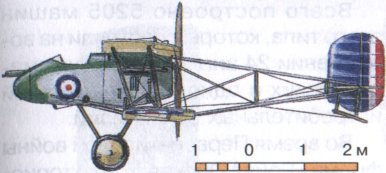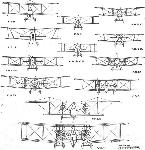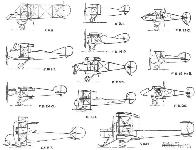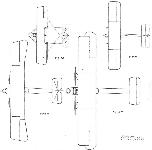А.Шепс Самолеты Первой мировой войны. Страны Антанты
Схему подобную RAF F.E.8 (истребитель с толкающим винтом) имели несколько машин, заказанных адмиралтейством для RNAS. Небольшие серии машин поставляла фирма "Виккерс". Последний из них, F.B.26 "Вампир" с двигателем "Испано-Сьюиза", поступил в 141 -и дивизион RNAS весной 1917 года. Однако слабые летные данные и дефицит двигателей (они шли в основном на истребитель S.F.5) послужили препятствием для крупносерийного производства.
C.Andrews Vickers Aircraft since 1908 (Putnam)
<...>
Also in the single-seat fighter class were the two Vickers pusher types, the F.B.12 and the F.B.26. Both had chequered careers.
<...>
The later F.B.26 pusher was a more sophisticated design originally intended as a single-seat night-fighter, powered with a 200 hp Hispano-Suiza. During an evening test flight on 25 August, 1917, Harold Barnwell spun the prototype into the ground just after take-off at Joyce Green, almost at the feet of his devoted mechanic H. J. Kingsnorth, who had just started up the aeroplane and was the only close witness of the fatal accident. The cause of this tragedy with so able a pilot remains a mystery. Writing from New Zealand, whence he emigrated in 1919, Kingsnorth said that he never recovered from the death of his hero Harold Barnwell, who, terse of speech and bluff in manner, had played a great part in the early development of British aviation, as did his brother, Capt Frank Barnwell, of the Bristol Aeroplane Company.
Three modified F.B.26s were built, and under the then recently introduced official nomenclature were named Vampire. One was modified as the F.B.26A, and named Vampire Mk II, with an armoured nacelle for ground attack, power being provided by the 230 hp Bentley B.R.2 rotary engine. But the contracts that were placed for this specialist duty type went to the Sopwith Salamander, a tractor biplane. One of the F.B.26s was fitted with the Eeman three-gun universal mounting, designed to increase fire power, but this armament proved unwieldy in practice. The F.B.26A was probably the last of the single-seat pusher fighters of the first world war, but the design philosophy was revived years later in the Vickers COW gun fighter of 1931.
F.B.26 - Vampire Mk I - One 200 hp Hispano Suiza. Span 31 ft 6 in, upper, and 29 ft. lower; length 23 ft 5 in; height 9 ft 5 in; wing area 267 sq ft. Empty weight 1,470 lb; gross weight 2.030 lb. Max speed 121 mph at 5,000 ft; climb to 10,000 ft - 10 min; service ceiling 20,500 ft; absolute ceiling 22,500 ft; endurance 3 hr. Armament twin fixed Lewis guns.
F.B.26A - Vampire Mk II - One 230 hp Bentley B.R.2. Span 31 ft 6 in, upper, and 27 ft 6 in, lower; length 22 ft 11 in; height 9 ft 5 in; wing area 267 sq ft. Empty weight 1,870 lb; gross weight 2.438 lb. Max speed 121 mph at ground level; climb to 10,000 ft - 12 min; absolute ceiling 19,000 ft; endurance 2 hr. Armament twin fixed Lewis guns.
P.Lewis The British Fighter since 1912 (Putnam)
May, 1917, was the month of the appearance of yet another ill-fated Vickers single-seat pusher fighter - the F.B.26 Vampire. Although very similar in general appearance to the same firm’s F.B.12 of the previous year, the Vampire had twice as much power in its 200 h.p. Hispano-Suiza engine and was rather larger and heavier. The two-bay style of wing cellule was retained with the nacelle fitted direct to the underside of the upper planes. A pair of Lewis guns in the nose of the nacelle armed the first F.B.26 but, after alterations to the wings, the cooling system and the vertical tail surfaces, the Vampire’s offensive power was increased by a third Lewis gun, the trio being on an Eeman mounting. The triple installation was tested both high up and low down in the nacelle, trials also being made with night-flying equipment installed.
Although, the following year, one of the Vampires - B1485 - appeared as the F.B.26A Vampire Mk.II, powered by the 230 h.p. Bentley B.R.2 rotary, with an armoured nacelle and twin Lewis guns for use as a trench-fighter, development was cancelled in favour of the rival Sopwith firm’s Salamander.
F.Mason The British Fighter since 1912 (Putnam)
Vickers F.B.26 Vampire
Another new Vickers pusher aircraft flown in 1917 was the single-seat F.B.26 (later named the Vampire), an altogether smaller aircraft than the F.B.25. It was originally designed as a day-flghting scout with a pair of Lewis guns in the extreme nose, and was powered by a 200hp Hispano-Suiza engine. As initially flown, the upper wing was, in characteristic Vickers fashion, devoid of centre section and the two halves were attached together on the aircraft’s centreline. The Hispano was at first installed with its car-type radiator at the rear of the engine; this however gave inadequate cooling and after an equally ineffective trial with a pair of radiators mounted transversely under the upper wing rear spar, these radiators were mounted vertically on the sides of the fuselage - and this arrangement sufficed. Various other changes were made to the wings (including the addition of a centre section) and tail unit and a four-blade propeller was substituted.
An Eeman triple-Lewis gun mounting was incorporated in the nose, and the revised prototype, now numbered B1484, underwent official trials at Martlesham Heath in July, returning a speed of 124 mph at sea level and demonstrating a service ceiling of 20,500 feet. Being fitted with flare brackets, it seems clear that the aircraft was then being considered in the role of anti-airship night fighter, and its demonstrated performance would seem to have been consistent with this role, while an excellent field of vision was afforded the pilot. Shortly after the aircraft returned to Joyce Green, the entire Eeman gun installation was raised almost a foot, probably to facilitate re-loading the guns in flight, but the new location severely reduced the pilot’s field of view and it was quickly discarded.
B1484 was to be destroyed in an accident on 25 August when it crashed from a spin shortly after taking off from Joyce Green, killing the famous pilot Harold Barnwell. A second aircraft, B1486, was built, probably during the autumn of 1917, also as a night fighter with the triple-gun Eeman installation. It was taken on charge by No 39 (Home Defence) Squadron at Woodford in October, and passed on to No 141 Squadron in February 1918, then at Biggin Hill; it was not much appreciated on account of poor flying qualities and the usual problem with the Hispano of lengthy warming up before take-off.
At least one other example, B1485, was built in 1918, this time powered by a 230hp Bentley B.R.2 rotary engine. This was intended as a trench fighter and featured 500 pounds of armour protection in the nacelle. The year 1918 also brought the official naming of military aircraft, Vickers aircraft being required to bear names beginning with ‘V’; thus the Bentley-powered F.B.26A became the Vampire Mk II, and, in retrospect, the Hispano-powered F.B.26, the Vampire Mk I. By the time the Vampire Mk II underwent its Service trials by the RAF, however, the Sopwith Salamander had been ordered into production as the principal British trench fighter, and the Vickers aircraft was abandoned.
Type: Single pusher engine, single-seat, single-bay biplane night fighter (Vampire Mk I) and trench fighter (Vampire Mk II).
Manufacturer: Vickers Ltd (Aviation Department), Knightsbridge, London.
Powerplant: Vampire Mk I. 200hp Hispano-Suiza; Vampire Mk II, 230hp Bentley B.R.2 rotary engine.
Dimensions: Span, 31ft 6in; length (Vampire Mk I), 23ft 5in; height, 9ft 5in; wing area, 267 sq ft.
Weights: Vampire Mk I. Tare, 1,407lb; all-up, 2,030lb.
Performance: Vampire Mk I. Max speed, approx 124 mph at sea level; climb to 10,000ft, 9 min 54 sec; service ceiling, 20,500ft; endurance, 3 hr.
Armament: Originally two 0.303in Lewis machine guns in extreme nose, increased to three in Eeman mounting; Vampire Mk II had two Lewis guns in the nose.
Prototypes: Total of six ordered, B1484-B1489; B1484 and B1486 were Vampire Mk Is, and B1485 a Vampire Mk II. B1487-B1489 probably not built. No production.
W.Green, G.Swanborough The Complete Book of Fighters
VICKERS F.B.26 VAMPIRE UK
Curiously retrogressive in design when built in May 1917, the pusher fighter with boom-carried empennage being decidedly passe at that stage in World War I, the F.B.26 single-seat fighter had its nacelle attached directly to the upper wing. The original concept provided for a single 0.303-in (7,7-mm) Lewis gun, but an additional Lewis had been introduced by the time that the F.B.26 reached Martlesham Heath for official testing in July 1917. Power was provided by a 200 hp Hispano-Suiza engine, but inadequate cooling led to the original single flat radiator being replaced by two separate radiator blocks. On 25 August 1917, the prototype was spun into the ground by Vickers' test pilot Harold Barnwell. Nonetheless, a month later, on 19 September, a contract was placed for six examples of a modified version of the F.B.26. The wing structure was completely revised, radiator blocks were attached to the nacelle sides and a larger vertical tail was introduced. Interest in the F.B.26 centred on its potential as a Home Defence fighter, and it was proposed that armament would consist of two Lewis guns coupled with an Aldis sight and capable of several degrees of elevation and depression. However, in order to obtain greater firepower, the nacelle of the F.B.26 was modified to permit installation of an Eeman three-gun universal mounting. The first two F.B.26s had the trio of Lewis guns fixed to fire horizontally, but it was intended that the next four aircraft would have a modified Eeman mounting capable of 45 deg of elevation. The first of the modified F.B.26s was flown in December 1917 with a 200 hp Hispano-Suiza engine. After testing at Martlesham Heath, this aircraft was assigned to No 141 Sqn in February 1918 for service evaluation. It was concluded that the F.B.26 was unsuited for Home Defence duties and work on the incomplete machines was halted, although the second and third examples had been completed and flown meanwhile. As the basic design was considered to possess potential in the close air support role, the second of the modified F.B.26s was fitted with a redesigned nacelle incorporating armour protection for the pilot and a 230 hp Bentley B.R.2 nine-cylinder rotary. This armoured "trench-strafer” was assigned the designation F.B.26A, and, under the official nomenclature scheme introduced in the spring of 1918, became the Vampire II, the F.B.26 being the Vampire I. In the event, the Vampire II had still to be completed by the end of June 1918, and thus came too late on the wartime scene. The following data are applicable to the Hispano-Suiza-engined modified F.B.26.
Max speed, 121 mph (195 km/h) at 5,000 ft (1525 m), 117 mph (188 km/h) at 10,000ft (3 050 m).
Time to 5,000 ft (1525 m), 4.33 min.
Service ceiling, 22,500 ft (6 860 m).
Endurance, 3,0 hrs.
Empty weight, 1,470 lb (667 kg).
Loaded weight, 2,030 lb (921 kg).
Span, 31 ft 6 in (9,63 m).
Length, 23 ft 5 in (7,14 m).
Height, 9 ft 5 in (2,87 m).
Wing area, 267 sqft (24,80 m2).
J.Bruce British Aeroplanes 1914-1918 (Putnam)
Vickers F.B.26, Vampire
CLEARLY proclaiming its descent from the Vickers F.B.12 pusher scout, the Vickers F.B.26 appeared in May 1917. It was a two-bay biplane with wings of unequal span and chord, and was fitted with a 200 h.p. Hispano-Suiza engine.
The F.B.26 originally had its upper wing made in two halves which met on the aircraft centre-line in typical Vickers fashion. The nacelle was attached directly to the upper wing. Under the nacelle there was a centre-section to which the lower mainplanes were attached. The outer pair of interplane struts on either side were raked sharply outwards. As on the F.B.12 and F.B.25 the tail-booms converged in side elevation to meet at the rear spar of the tailplane. A plain vee undercarriage was fitted: the forward leg of each vee was attached to the lower longeron of the nacelle; the rear leg was attached to the front spar of the lower centre-section.
The radiator was at first installed as a plain flat vertical surface at the extreme rear of the nacelle, but this did not give adequate cooling. Two separate radiator blocks were next tried; one was fitted under the rear spar of each upper wing immediately above the engine. The final radiator installation consisted of twin radiators mounted on the sides of the nacelle; each element was below and in front of the engine.
By the time the side radiators were installed the design of the F.B.26 had undergone modification. A completely new wing structure was introduced: both upper and lower wings had wide centre-sections which spanned the distance between the inboard pairs of interplane struts, and only the outer portions of both wings were rigged with dihedral. The span of the lower ailerons was increased, and a new fin and rudder were fitted; the new surfaces were of higher aspect-ratio than those originally fitted.
In its first form the F.B.26 had been armed with two Lewis guns mounted side-by-side in the nose of the nacelle. The modified machine was fitted with the experimental Eeman triple mounting, which carried three Lewis guns. The F.B.26 was flown both with the guns relatively low down and with them raised above the upper longerons of the nacelle; in the latter case the nacelle was built up unusually high in front of the cockpit. The lower installation proved to be satisfactory (though the reloading of three separate Lewis guns in the heat of combat would almost certainly have proved to be something of a trial for the pilot); but the elevated installation was regarded as unwieldy and was abandoned. It must have interfered seriously with the pilot’s forward view.
The early F.B.26 was test-flown at Joyce Green by Harold Barnwell, who permitted Captain J. T. B. McCudden to fly it. (As is related in the history of the Vickers F.B.16, McCudden was at that time an instructor at Joyce Green.) He found that the F.B.26 “was very much the same as an F.E.8 to fly.” The type was also flown by Captain W. G. Barker (later Major Barker, V.C., D.S.O., M.C.), who thought well of it.
The modified F.B.26 with the lower Eeman gun-mounting was at one time fitted with flare brackets under the lower wing and a generator on the forward leg of the starboard undercarriage vee. The aircraft was clearly equipped for night-flying, and may have been the F.B.26 which was sent to No. 141 Squadron in 1918. The aircraft was not popular in the squadron: although it was fast it had poor climbing characteristics, and was unpleasant to spin, for its speed of rotation was very great. It is believed, however, that an F.B.26 was with No. 39 Squadron at North Weald in October, 1917, but it is uncertain whether this was the same aircraft that went to No. 141 Squadron.
In 1918 a new variant of the F.B.26 appeared. The Vickers F.B.26A was an armoured trench-fighter with a 230 h.p. Bentley B.R.2 rotary engine in place of the Hispano-Suiza of the original version; the airframe was that of the second F.B.26, B.1485. The nose of the nacelle was a little blunter and shorter, and the engine was mounted well forward in order to keep the centre of gravity in the correct place. The F.B.26A nacelle was therefore shorter overall than that of the F.B.26, and a cut-out had to be made in the upper centre-section to permit the engine to rotate. The disposition of the lower centre-section struts had to be altered, and the rear leg of each undercarriage vee was attached to the rear spar of the lower centresection instead of to the front spar as on the F.B.26.
The wings and tail unit of the F.B.26A were identical in form to those of the modified F.B.26.
By this time the Eeman triple gun-mounting had been abandoned, and the armament consisted of a pair of Lewis guns in the nose of the nacelle. The armour plate, which weighed 500 lb, was apparently fitted inside the nacelle structure, and the pusher arrangement of the aircraft enabled both pilot and engine to be protected by the armour.
By the time the Vickers F.B.26A appeared the official scheme for naming aeroplanes was in being. The name Vampire was given to the F.B.26 design: the F.B.26 with Hispano-Suiza engine was designated Vampire Mark I; the F.B.26A became the Vampire Mk. II.
The Vampire Mk. II was reported to be a good aeroplane with excellent manoeuvrability. Its performance was remarkably good for a pusher, and the pilot had a clear forward view for ground-strafing. But the Sopwith Salamander had been adopted as the standard trench-fighter, and the Vampire was abandoned.
SPECIFICATION
Manufacturers: Vickers Ltd. (Aviation Department), Imperial Court, Basil Street, Knightsbridge, London, S.W. The F.B.26s were built at Vickers’ Bexley Heath works.
Power: F.B.26: 200 h.p. Hispano-Suiza. F.B.26A: 230 h.p. Bentley B.R.2.
Dimensions: Span: upper 31 ft 6 in.; lower (original F.B.26) 29ft, (modified F.B.26 and F.B.26A) 27 ft 6 in. Length: (F.B.26) 23 ft 5 in., (F.B.26A) 22 ft 11 in. Height: 9 ft 5 in. Chord: upper 5 ft 6 in., lower 4 ft 6 in. Gap: (F.B.26) 4ft 3 in. (modified F.B.26 and F.B.26A) 4ft 4 1/4 in. Stagger: 1 ft 6 in. Dihedral: (F.B.26) 3° 30', (modified F.B.26 and F.B.26A) 4°. Incidence: 2°. Span of tail: 12 ft 3 in. Airscrew diameter: (F.B.26A) 8 ft 9 in.
Areas: (modified F.B.26 and F.B.26A) Wings: upper 158 sq ft, lower 109 sq ft, total 267 sq ft. Ailerons: each upper 12 sq ft, each lower 6 sq ft, total 36 sq ft. Tailplane: 22 sq ft. Elevators: 16 sq ft. Fin: 6-4 sq ft. Rudder: 6-7 sq ft.
Weights (lb) and Performance:
Aircraft F.B.26 F.B.26A
No. of Trial Report M.127 -
Date of Trial Report July, 1917 -
Weight empty 1,470 1,870
Military load 80 230
Pilot 180 180
Fuel and oil 300 158
Weight loaded 2,030 2,438
Maximum speed (m.p.h.) at
ground level - 121
5,000 ft 121 118
10,000 ft 117 115
m. s. m. s.
Climb to
5,000 ft 4 20 5 00
6,500 ft 6 00 - -
10,000 ft 9 54 12 00
15,000 ft 18 56 - -
Ceiling: service (feet) 20,500 -
absolute (feet) 22,500 19,000
Endurance (hours) 3 2
Tankage: F.B.26. Petrol: main tank 31 gallons, gravity tank 2 gallons, total 33 gallons. F.B.26A. Petrol: 29 gallons. Oil: 6 gallons.
Armament: The F.B.26 (Vampire I) had twin Lewis machine-guns in the nose of the nacelle firing forward; later, three Lewis guns on an Eeman triple mounting were fitted. The F.B.26A (Vampire II) had twin Lewis guns in the nose of the nacelle.
Service Use: One Vickers F.B.26 was sent to a Home Defence unit in 1918. It is believed that the type was flown by Nos. 39 and 141 Squadrons, R.F.C.
Serial Numbers: B.1484-B.1489, ordered under Contract No. A.S.27055/1. At least three (B.1484-B.1486) were built; B.1485 became the Vampire II.
H.King Armament of British Aircraft (Putnam)
Vampire. Intended to have a single Lewis gun, the first F.B.26 (type later named Vampire) materialised in 1917 with two of these guns, set far forward in the nacelle well below the cockpit sill. As developed for Home Defence the Vampire was associated with some uncommonly interesting armament schemes. The Eeman mounting, with three Lewis guns, was fitted, at first as a fixed installation (raised higher in the nacelle on the third example) but with the intention that the mounting could eventually be elevated, in harmony with an Aldis sight, through 45 degrees. Eleven 97-round ammunition drums were specified. Adapted for ground attack, under the designation Vampire II, this aircraft had two Lewis guns set side by side in an armoured nacelle. The fitting of a BR.2 rotary aircooled engine in place of the earlier water-cooled types rendered this version less vulnerable lo ground fire. Carrying 500 lb of armour-plate, the Vampire II weighed 1.870 lb.
Jane's All The World Aircraft 1919
THE VICKERS "VAMPIRE."
The Vickers " Vampire" is a small single seater pusher biplane designed primarily for trench fighting.
The small nacelle is directly under the undersurface of the upper plane and is connected to the lower plane by short struts. The tail booms are fitted at the ends of each of the rear inner interplane struts and are parallel in plan view but, in elevation, converge at the fixed tail plane. The chassis is of the customary Vee-type rubber sprung.
Specification.
Type of machine Pusher Biplane, single-seater
Name or type No. of machine "Vampire" B.R. 2
Purpose for which intended Trench fighting.
Span Top 31 ft. 6 in.; bot. 27ft. 6 in.
Gap, maximum and minimum 52 in.
Overall length 22 ft. 11 In.
Maximum height 9 ft. 5 in.
Chord Top 5 ft 6 in.; bot. 4 ft. 6 In.
Total surface of wings 267 sq. ft.
Span of tail 12 ft. 3 in.
Total area of tail 38 sq. ft.
Area of elevators 16 sq.ft.
Area of rudder 6.7 sq. ft.
Area of fin 6.4 sq. ft.
Area of each aileron and total area (2x12)+(2x6) = 36sq ft.
Maximum cross section of body 7.6 sq. ft.
Horizontal area of body 16.6 sq ft.
Vertical area of body 24.5 sq. ft.
Engine type and h.p. B.R. 2; 200 h.p.
Airscrew, diam., pitch, and revs. 8.75 ft., 9 ft., 1,300
Weight of machine empty
(including 500 lbs. steel armour) 1,870 lbs.
Load per sq. ft. 9.1 lbs.
Weight per h.p. (228 h.p.) 10.7 lbs.
Tank capacity in gallons Petrol 29 galls.; oil 6 galls
Performance.
Speed low down 121 m.p.h.
Speed at 10.000 feet 115 m.p.h.
Landing speed 54 m.p.h
Climb.
To 5,000 feet 5 minutes.
To 10,000 feet 12 minutes.
Disposable load apart from fuel
(including crew) 568 lbs.
Total weight of machine loaded 2,438 lbs.
Журнал Flight
Flight, June 12, 1919.
"MILESTONES"
THE VICKERS MACHINES
The F.B. 26. (July, 1917)
The F.B. 26, constructed in July, 1917, was the outcome of the first Pusher Scout, the F.B. 12, which, having proved so handy, was modified to take the 150 h.p. Hispano-Suiza engine. This machine was flown by Capt. Barker and Capt. McCudden, V.C., D.S.O., both of whom were very pleased with its performance and general manceuvreability. Six more were constructed to take Eeman triple gun-mounts; both forward and elevated, the forward mountings proving very satisfactory, but the elevated mountings, being too unwieldy, were abandoned. The machines were tested at Martlesham, and later at Biggin Hill.
A further modification, which was armoured and intended for trench strafing, was also constructed to take the 200 h.p. B.R. 2 engine, the results proving eminently satisfactory. At the conclusion of hostilities, Messrs. Vickers, Ltd., were still awaiting orders concerning this type of machine.


















